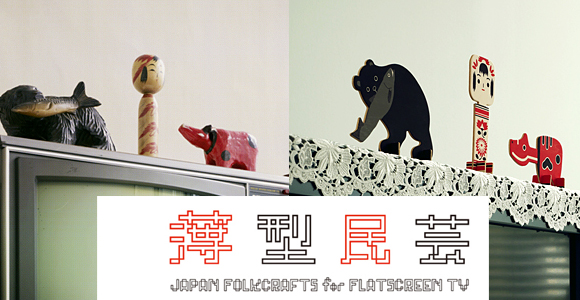
For those of us old enough to remember having a huge CRT style television it was certainly the household’s prime location for your best knickknacks. It had the most eye traffic after all.
However, with many TV tops nowadays measuring an inch in thickness that custom has become endangered. So, Japan Folkcrafts for Flatscreen TV was created. Applying the axiom “if you can’t beat ‘em join ‘em,” some of Japan’s favorite trinkets have become flattened to fit on current TV models.
You might be wondering why this concerted effort to save things put on the TV exists. Some of the most typical bric-a-brac actually have their own unique and deep connection to the history of Japan.
■ Wood Carving of a Bear (Kibori No Kuma)
It all started around 1921 when member of Parliament and descendant of the powerful Tokugawa Clan, Yoshichika Tokugawa took a trip to Switzerland. While there he took a fancy to a wooden carving of a bear and bought it as a souvenir.
After returning to Japan he noticed that the farmers in Hokkaido were struggling to make money during the harsh winter months. So he recommended that they take up carving wooden bears like his to make some extra cash in the off season – and they did.
Nearly a hundred years and millions of bears later the Hokkaido wooden bears can be found all over Japan.
■ Red Cow (Aka Beko)
■ Kokeshi
The reason for both these items’ popularity was a superstition that red colored toys would protect children from smallpox, which was running rampant at the time in Japan.
There are theories that kokeshi were actually originally designed to be either tools for abortion or memorials of them. These theories however are based on little more than the fact that the word “kokeshi” in Japanese can be interpreted to mean “child removal.”
■ Panda
From that point on panda-monium struck Japan, whose people value cuteness more than anyone. Panda merchandise was flying off the shelves left and right and the phrase “Panda Barker” (Kyaku Yose Panda) was coined in Japanese. “Barker” is in the sense of a carnival barker, a panda barker is something so special that it brings in people/customers by the droves.
Perhaps Japan’s continuing love of pandas can help take them back to a more optimistic time with China.
These four knickknacks had a lot to teach about the history of Japan, and it looks like the makers of Folkcrafts for Flatscreen TV have more in the pipeline.
So if you’re lucky enough to stumble upon a CRT model television take look through those dusty ornaments on top. You might learn something.
Source: Japan Folkcrafts for Flatscreen TV via KiYOTO (Japanese)
▼Unfortunately, these cows’ heads don’t bobble.
▼They seem to be able to stand on the thinnest of things.